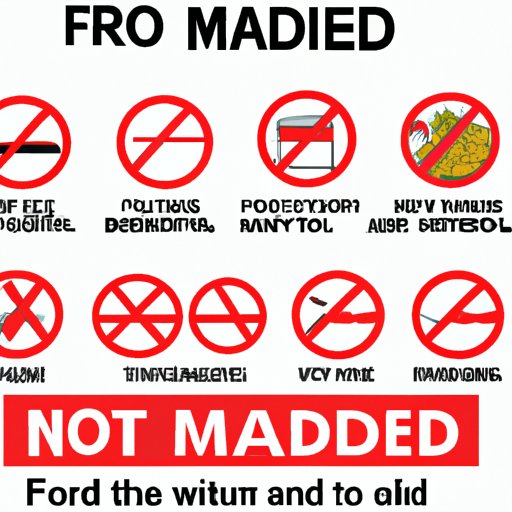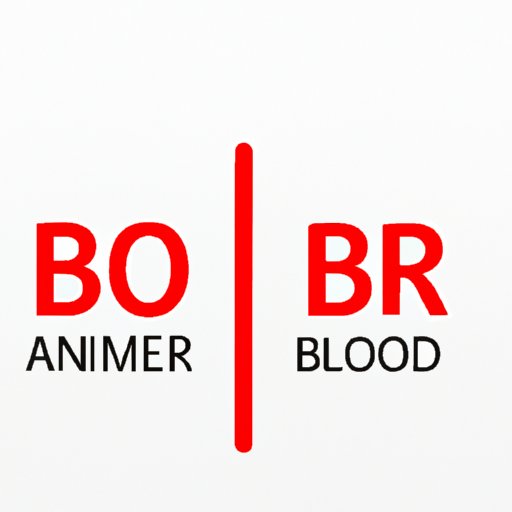Introduction
Eating for your blood type is a popular concept that suggests that certain foods are better suited for people with different types of blood. It was first introduced in 1996 by naturopathic physician Peter J. D’Adamo, who wrote the book Eat Right 4 Your Type. The idea behind it is that different blood types have evolved over time to digest certain food groups better than others.
In this article, we will explore the concept of eating for your blood type and provide tips on what kinds of food are beneficial for each blood type. We will also discuss the importance of incorporating plant-based proteins into your diet, choosing organic and non-GMO products, avoiding processed and refined foods, reducing or eliminating sugar and alcohol intake, eating smaller portions throughout the day, and drinking plenty of water.

Learn the Foods That Are Beneficial for Your Blood Type
The first step in eating for your blood type is to learn which foods are beneficial for your particular type. According to D’Adamo, people with different blood types have different reactions to certain food groups. For example, people with type A blood are said to be best suited for a vegetarian diet, while people with type O blood should focus on high-protein foods such as lean meats and seafood.
Here are some general tips for incorporating foods that are beneficial for your blood type:
- Eat a variety of fresh fruits, vegetables, whole grains, nuts, and legumes.
- Focus on foods that are unprocessed and naturally low in fat and sodium.
- Choose organic, non-GMO, and locally grown foods when possible.
- Limit or avoid processed and refined foods such as white bread, white rice, and sugary snacks.
- Reduce or eliminate your intake of sugar and alcohol.
- Eat smaller portions throughout the day rather than one or two large meals.
- Drink plenty of water throughout the day.
Here are some specific food suggestions for each blood type:
- Type A: Fruits and vegetables, beans and legumes, whole grains, nuts and seeds, fish, and tofu.
- Type B: Fruits and vegetables, eggs, lean meats, nuts and seeds, dairy products, and tofu.
- Type AB: Fruits and vegetables, beans and legumes, eggs, lean meats, fish, tofu, and dairy products.
- Type O: Fruits and vegetables, lean meats, seafood, nuts and seeds, and tofu.
Incorporate Plant-Based Proteins Into Your Diet
Incorporating plant-based proteins into your diet is an important part of eating for your blood type. Plant-based proteins are rich in essential vitamins, minerals, and fiber, and they can help you feel fuller for longer. Studies have also shown that plant-based proteins can reduce your risk of heart disease, stroke, and diabetes.
Here are some tips for incorporating plant-based proteins into meals:
- Add beans, nuts, and seeds to salads, soups, and stir-fries.
- Substitute tofu for chicken or beef in dishes like tacos and stir-fries.
- Snack on hummus and carrots, nut butter and apple slices, or roasted chickpeas.
- Make smoothies with almond milk, banana, and protein powder.
- Add quinoa or lentils to soups, salads, and casseroles.
Choose Organic and Non-GMO Products
Choosing organic and non-GMO products is another important part of eating for your blood type. Organic foods are grown without the use of synthetic pesticides, herbicides, and fertilizers, while non-GMO products are not genetically modified. Both organic and non-GMO products are higher in nutrients and lower in toxins, which is beneficial for overall health.
Here are some tips for identifying organic and non-GMO products:
- Look for the USDA organic label, which means the product has been certified organic.
- Look for the Non-GMO Project Verified label, which means the product has been verified as non-GMO.
- Read labels to check for ingredients that are likely to be genetically modified, such as soy, corn, and canola.
- Shop at farmers markets and local health food stores for organic and non-GMO products.

Avoid Processed and Refined Foods
Processed and refined foods are another type of food to avoid when eating for your blood type. These foods are typically high in added sugars, unhealthy fats, and sodium, which can lead to weight gain and other health problems. Studies have also linked processed and refined foods to an increased risk of heart disease, diabetes, and cancer.
Here are some tips for avoiding processed and refined foods:
- Read labels and look for foods that have minimal ingredients.
- Avoid foods with added sugars, unhealthy fats, and sodium.
- Shop the perimeter of the grocery store, where the freshest and least processed foods are found.
- Limit your consumption of fast food and packaged snacks.
- Cook meals from scratch using fresh ingredients.

Reduce or Eliminate Sugar and Alcohol Intake
Reducing or eliminating your intake of sugar and alcohol is another important step in eating for your blood type. Excess sugar and alcohol can lead to weight gain, inflammation, and other health problems. Studies have also linked sugar and alcohol to an increased risk of heart disease, diabetes, and certain types of cancer.
Here are some tips for reducing or eliminating sugar and alcohol intake:
- Limit your intake of sugary drinks such as sodas and juices.
- Avoid processed and refined foods that contain added sugars.
- Replace sugary snacks with healthier options such as fruit and nuts.
- Limit your intake of alcohol to no more than one drink per day.
- Choose low-sugar and low-alcohol beverages when possible.
- Opt for sparkling water instead of soda or juice.
Eat Smaller Portions Throughout the Day
Eating smaller portions throughout the day is another important part of eating for your blood type. Eating smaller portions can help you control your calorie intake and prevent overeating. Studies have also shown that eating smaller portions can reduce your risk of obesity, diabetes, and other health problems.
Here are some tips for portion control:
- Measure out servings using measuring cups or spoons.
- Divide your plate into three sections: half of the plate should be filled with vegetables, one quarter with a lean protein, and one quarter with a healthy carbohydrate.
- Eat slowly and stop when you start to feel full.
- Drink plenty of water throughout the day to help you feel full.
- Plan ahead and pack healthy snacks for times when you know you’ll be hungry.
Drink Plenty of Water
Drinking plenty of water is essential for overall health, and it’s especially important when eating for your blood type. Staying hydrated helps your body absorb nutrients, flush out toxins, and regulate your metabolism. Studies have also shown that drinking plenty of water can help you lose weight and reduce your risk of chronic diseases.
Here are some tips for drinking plenty of water:
- Carry a refillable water bottle with you throughout the day.
- Drink a glass of water before meals to help you feel fuller.
- Drink a glass of water after exercise to stay hydrated.
- Flavor your water with lemon, lime, or cucumber for added flavor.
- Set reminders on your phone or watch to remind yourself to drink water.
Conclusion
In conclusion, eating for your blood type can be beneficial for overall health. It involves learning which foods are beneficial for each blood type, incorporating plant-based proteins into your diet, choosing organic and non-GMO products, avoiding processed and refined foods, reducing or eliminating sugar and alcohol intake, eating smaller portions throughout the day, and drinking plenty of water. By following these tips, you can ensure that you are getting the most out of your diet and living a healthier lifestyle.
(Note: Is this article not meeting your expectations? Do you have knowledge or insights to share? Unlock new opportunities and expand your reach by joining our authors team. Click Registration to join us and share your expertise with our readers.)
